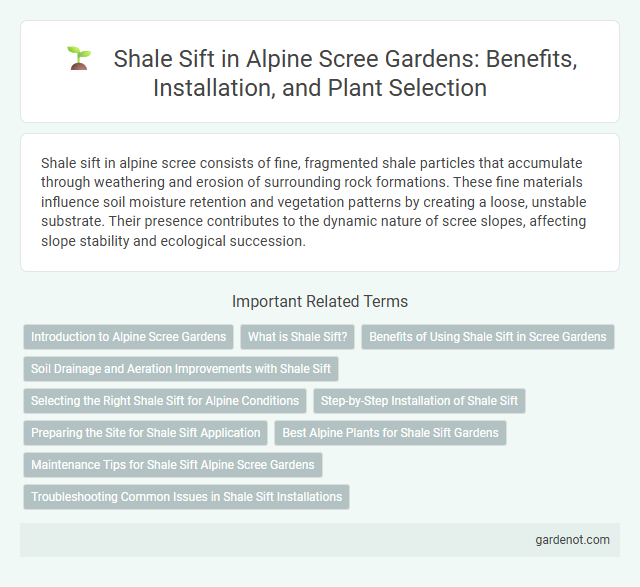Shale sift in alpine scree consists of fine, fragmented shale particles that accumulate through weathering and erosion of surrounding rock formations. These fine materials influence soil moisture retention and vegetation patterns by creating a loose, unstable substrate. Their presence contributes to the dynamic nature of scree slopes, affecting slope stability and ecological succession.
Introduction to Alpine Scree Gardens
Shale sift is a fundamental component in alpine scree gardens, providing well-drained, mineral-rich substrate that mimics natural mountain scree environments. Its fine, angular particles facilitate excellent aeration and moisture retention, supporting the specialized root systems of alpine plants. Using shale sift enhances the establishment and growth of drought-tolerant, rock-adapted species vital for authentic alpine garden ecosystems.
What is Shale Sift?
Shale sift refers to the fine fragments and particles derived from the weathering and erosion of shale rock commonly found in alpine scree environments. These small shale components contribute to the loose, unstable substrate characteristic of scree slopes, influencing soil composition and drainage. Understanding shale sift is essential for studying sediment transport and ecological dynamics in mountainous regions.
Benefits of Using Shale Sift in Scree Gardens
Shale sift enhances alpine scree gardens by improving soil drainage and aeration, crucial for preventing root rot in drought-tolerant plants. Its mineral-rich composition promotes nutrient retention, supporting healthy growth of alpines and succulents. Lightweight and stable, shale sift also helps maintain soil structure on slopes, reducing erosion and promoting long-term garden sustainability.
Soil Drainage and Aeration Improvements with Shale Sift
Shale sift enhances soil drainage in alpine scree by creating a loose, porous layer that facilitates rapid water percolation, preventing waterlogging and root rot. Its fine, angular particles improve aeration, promoting healthy root respiration and microbial activity essential for plant growth in harsh alpine environments. Incorporating shale sift boosts soil structure stability, supporting vegetation establishment on steep, rocky slopes.
Selecting the Right Shale Sift for Alpine Conditions
Selecting the right shale sift for alpine scree requires careful consideration of durability and particle size to withstand harsh mountainous environments. Optimal shale sift should exhibit high resistance to weathering and frost, ensuring stability on steep and unstable slopes. Using well-graded shale with fine to medium particles improves water drainage and reduces erosion risks inherent in alpine terrain.
Step-by-Step Installation of Shale Sift
Shale sift installation begins with selecting a stable base layer, typically coarse gravel or crushed rock, to ensure proper drainage and support. Next, carefully spread the shale sift evenly over the prepared base, maintaining a consistent thickness of approximately 2 to 3 inches for optimal stability. Finally, compact the shale sift using a mechanical compactor or hand tamper to create a firm, level surface ideal for alpine scree landscaping applications.
Preparing the Site for Shale Sift Application
Preparing the site for shale sift application requires thorough clearing of loose debris and vegetation to ensure optimal contact between the shale material and the ground surface. Proper grading and leveling promote even distribution and effective drainage, minimizing erosion risks on alpine scree slopes. Installing barriers or retaining structures may stabilize the area, enhancing the overall success of shale sift integration in alpine environments.
Best Alpine Plants for Shale Sift Gardens
Shale sift creates a nutrient-rich, well-draining soil ideal for alpine scree gardens, supporting plants like Saxifraga oppositifolia, Androsace septentrionalis, and Sedum acre that thrive in rocky, low-fertility environments. Best alpine plants for shale sift gardens exhibit drought tolerance and compact growth, making them perfect for creating naturalistic scree slopes. Incorporating species such as Silene acaulis and Draba aizoides enhances biodiversity while maintaining aesthetic appeal in shale-based alpine scree landscapes.
Maintenance Tips for Shale Sift Alpine Scree Gardens
Shale sift in Alpine scree gardens requires regular maintenance to ensure proper drainage and prevent soil compaction. Raking the shale sift periodically helps to remove debris and promotes air circulation around alpine plants. Monitoring moisture levels and avoiding overwatering protects the delicate root systems and preserves the shale's structural integrity.
Troubleshooting Common Issues in Shale Sift Installations
Shale sift installations in alpine scree often face challenges such as clogging due to fine shale particles and uneven settling that impacts filtration efficiency. Regular maintenance includes checking for sediment buildup and ensuring proper alignment of sift components to prevent operational disruptions. Addressing moisture accumulation with adequate drainage solutions reduces the risk of material degradation and enhances the lifespan of shale sift systems.
Shale sift Infographic

 gardenot.com
gardenot.com